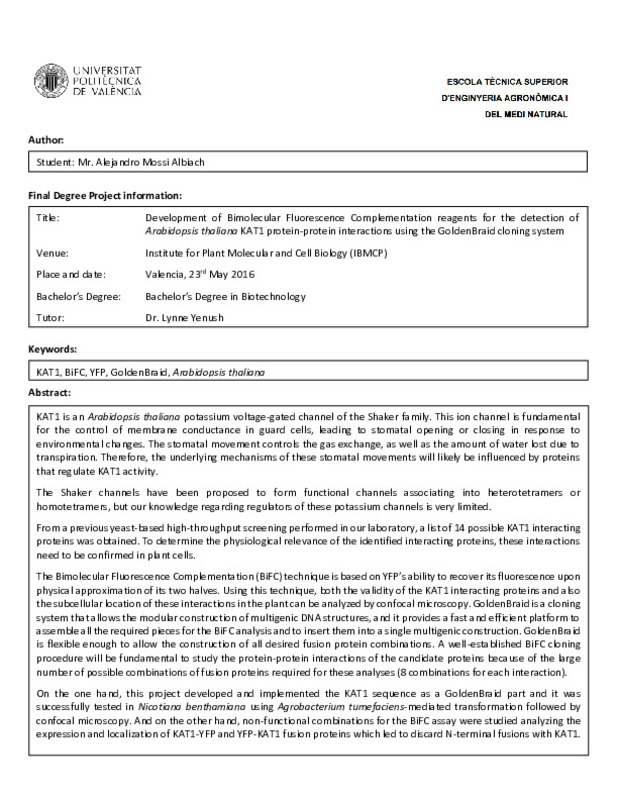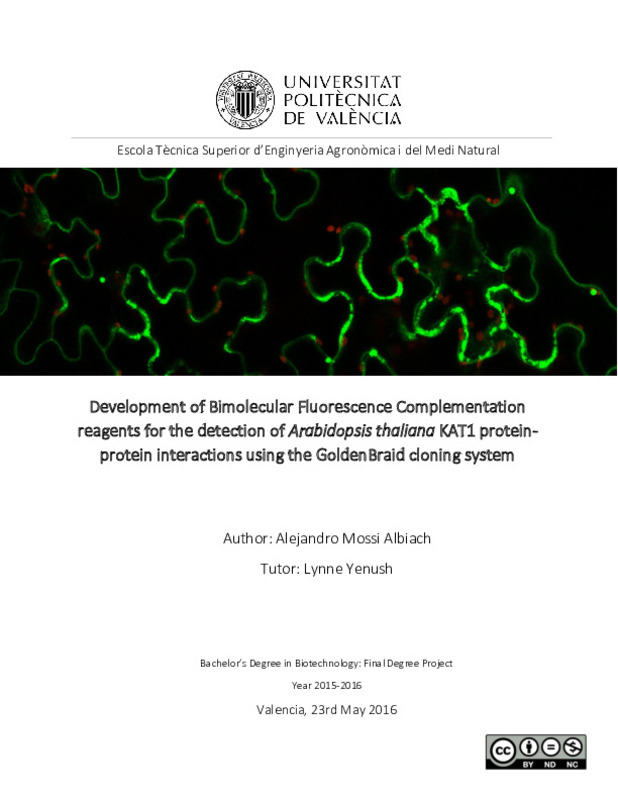|
Resumen:
|
[EN] KAT1 is an Arabidopsis thaliana potassium voltage-gated channel of the Shaker family. This ion channel is fundamental
for the control of membrane conductance in guard cells, leading to stomatal opening or closing in ...[+]
[EN] KAT1 is an Arabidopsis thaliana potassium voltage-gated channel of the Shaker family. This ion channel is fundamental
for the control of membrane conductance in guard cells, leading to stomatal opening or closing in response to
environmental changes. The stomatal movement controls the gas exchange, as well as the amount of water lost due to
transpiration. Therefore, the underlying mechanisms of these stomatal movements will likely be influenced by proteins
that regulate KAT1 activity.
The Shaker channels have been proposed to form functional channels associating into heterotetramers or
homotetramers, but our knowledge regarding regulators of these potassium channels is very limited.
From a previous yeast-based high-throughput screening performed in our laboratory, a list of 14 possible KAT1 interacting
proteins was obtained. To determine the physiological relevance of the identified interacting proteins, these interactions
need to be confirmed in plant cells.
The Bimolecular Fluorescence Complementation (BiFC) technique is based on YFP’s ability to recover its fluorescence upon
physical approximation of its two halves. Using this technique, both the validity of the KAT1 interacting proteins and also
the subcellular location of these interactions in the plant can be analyzed by confocal microscopy. GoldenBraid is a cloning
system that allows the modular construction of multigenic DNA structures, and it provides a fast and efficient platform to
assemble all the required pieces for the BiFC analysis and to insert them into a single multigenic construction. GoldenBraid
is flexible enough to allow the construction of all desired fusion protein combinations. A well-established BiFC cloning
procedure will be fundamental to study the protein-protein interactions of the candidate proteins because of the large
number of possible combinations of fusion proteins required for these analyses (8 combinations for each interaction).
On the one hand, this project developed and implemented the KAT1 sequence as a GoldenBraid part and it was
successfully tested in Nicotiana benthamiana using Agrobacterium tumefaciens-mediated transformation followed by
confocal microscopy. And on the other hand, non-functional combinations for the BiFC assay were studied analyzing the
expression and localization of KAT1-YFP and YFP-KAT1 fusion proteins which led to discard N-terminal fusions with KAT1.
[-]
[CA] KAT1 és un canal de potassi regulat per voltatge d’Arabidopsis thaliana que pertany a la família Shaker. Aquest canal de
ions és fonamental per al control de la conductància a la membrana de les cèl·lules guarda, ...[+]
[CA] KAT1 és un canal de potassi regulat per voltatge d’Arabidopsis thaliana que pertany a la família Shaker. Aquest canal de
ions és fonamental per al control de la conductància a la membrana de les cèl·lules guarda, causant l’obertura o el
tancament dels estomes en resposta als canvis ambientals. El moviment dels estomes controla l’intercanvi de gasos, així
com la perduda d’aigua per transpiració. Per aquesta raó, els mecanismes subjacents als moviments estomàtics estan
probablement influenciats per les proteïnes que regulen l’activitat de KAT1.
S’ha proposat que els canals Shaker s’associen formant heterotetramers o homotetramers per tal de formar un canal
funcional, però el nostre coneixement sobre els reguladors d’aquests canals de potassi és molt limitat.
A partir d’un cribratge d’alt rendiment basat en llevat realitzat al nostre laboratori, es va obtindré una llista de 14 possible
proteïnes que interaccionen amb KAT1. Per tal de determinar la rellevància fisiològica de les possibles proteïnes que
interaccionen amb KAT1, aquestes interaccions han de ser confirmades en cèl·lules vegetals.
La Complementació Bimolecular de Fluorescència (BiFC) és una tècnica basada en l’habilitat de YFP, que és capaç de
recobrar la seva fluorescència per la aproximació de les seves dues meitats. Utilitzant aquesta tècnica, la validesa de les
proteïnes que interaccionen amb KAT1 i també la localització subcel·lular d’aquestes interaccions en la planta podrà ser
analitzada mitjançant microscòpia confocal. GoldenBraid es un sistema de clonatge que permet la construcció de manera
modular d’estructures de DNA, i proporciona una plataforma ràpida i eficient per muntar totes les peces que es
requereixen per a realitzar la BiFC i insertar-les en una sola unitat multigènica. El sistema GoldenBraid és suficientment
flexible com per a permetre la construcció de totes les combinacions de proteïnes de fusió. Un protocol ben establert de
BiFC serà fonamental per estudiar les interaccions proteïna-proteïna de les proteïnes candidates degut a l’elevat nombre
de combinacions possibles de proteïnes de fusió que es requereixen per a aquests anàlisis (8 combinacions per a cada
interacció).
Per un costat, aquest projecte ha desenvolupat i implementat la seqüència de KAT1 com a una part del GoldenBraid i va
ser provada amb èxit en Nicotiana benthamiana utilitzant una transformació mitjançant Agrobacterium tumefaciens
seguida del anàlisis per microscòpia confocal. I per altre costat, les combinacions no funcionals per a l’assaig de BiFC
sigueren estudiades analitzant l’expressió i localització de les proteïnes de fusió KAT1-YFP i YFP-KAT1, fets que portaren a
descartar les fusions N-terminals de KAT1.
[-]
|








